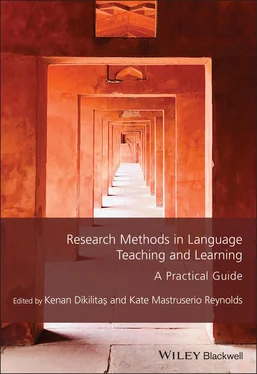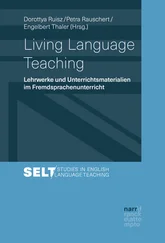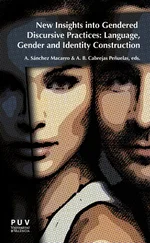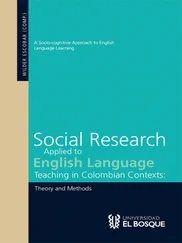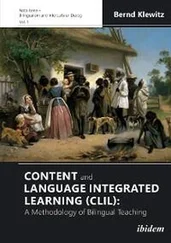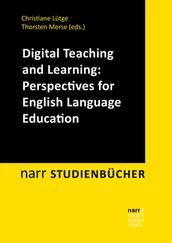Research Methods in Language Teaching and Learning
Здесь есть возможность читать онлайн «Research Methods in Language Teaching and Learning» — ознакомительный отрывок электронной книги совершенно бесплатно, а после прочтения отрывка купить полную версию. В некоторых случаях можно слушать аудио, скачать через торрент в формате fb2 и присутствует краткое содержание. Жанр: unrecognised, на английском языке. Описание произведения, (предисловие) а так же отзывы посетителей доступны на портале библиотеки ЛибКат.
- Название:Research Methods in Language Teaching and Learning
- Автор:
- Жанр:
- Год:неизвестен
- ISBN:нет данных
- Рейтинг книги:5 / 5. Голосов: 1
-
Избранное:Добавить в избранное
- Отзывы:
-
Ваша оценка:
- 100
- 1
- 2
- 3
- 4
- 5
Research Methods in Language Teaching and Learning: краткое содержание, описание и аннотация
Предлагаем к чтению аннотацию, описание, краткое содержание или предисловие (зависит от того, что написал сам автор книги «Research Methods in Language Teaching and Learning»). Если вы не нашли необходимую информацию о книге — напишите в комментариях, мы постараемся отыскать её.
Research Methods in Language Teaching and Learning
Research Methods in Language Teaching and Learning
Research Methods in Language Teaching and Learning — читать онлайн ознакомительный отрывок
Ниже представлен текст книги, разбитый по страницам. Система сохранения места последней прочитанной страницы, позволяет с удобством читать онлайн бесплатно книгу «Research Methods in Language Teaching and Learning», без необходимости каждый раз заново искать на чём Вы остановились. Поставьте закладку, и сможете в любой момент перейти на страницу, на которой закончили чтение.
Интервал:
Закладка:
Collective case studies that do not gather observational data suffer also from the limitation that it is harder to take the reader into the heart of the action through providing the “thick description” (Geertz, 1973) that can make the case strong on reality (Nisbet & Watt, 1984) and support vicarious experience in the reader, optimizing the reader’s opportunities to reflect and learn (Stake, 1995). However, even when observational data are drawn upon, it does not, of course, invariably follow that “thick description” (Geertz, 1973) will be used; for example, in a collective case study of six mathematics teachers that did employ observations, Katz and Stupel (2016) presented their qualitative data in a way that did not draw the reader into the teachers’ stories. Consequently, the strengths of case study, in focusing on the particularities of experience and providing readers “with good raw material for their own generalizing” (Stake, 1995, p. 102), were not fully exploited.
The Need for More Qualitative Case Study Research Into LTSE Beliefs
As should be evident so far, interpretive qualitative case study has been underexploited in research into LTSE beliefs, particularly given the need for such research, highlighted above. Longitudinal qualitative case studies of preservice English language teachers, for example, following these teachers through their practicums and first years of teaching, much as Mulholland and Wallace (2001) did with a beginning science teacher, could provide valuable insights. Preservice English language teachers are not ignored in the LTSE beliefs literature (Wyatt, 2018a, 2018b); indeed, several studies set in Turkey have followed cohorts of preservice teachers into their beginning years. Individual case studies have not resulted from such research initiatives, however.
The individual case studies of English language teachers we do have (Wyatt, 2010b, 2013a) were both of in-service teachers adjusting to new and challenging situations, one switching from teaching Grade 9 to Grade 1, and the other moving from teaching a curriculum in which there was no group work in a school in which the students’ desks were in rows, to an entirely different situation in which group work was important. In many contexts, as curricula and teaching assignments change, in-service language teachers’ tasks can change quite dramatically; this can impact their LTSE beliefs in ways which case study research could investigate.
One point of interest in LTSE beliefs research is in how these beliefs intersect with language proficiency to shape teaching behavior (e.g., Wyatt & Dikilitaş, 2019).
However, the case studies above (Wyatt, 2010b, 2013a) shed little light on this issue, as they were of Omani English teachers largely secure in their use of the target language. In contrast, in contexts such as Korea and Vietnam (Hiver, 2013; Phan, 2015), limited language proficiency can unfortunately be a major issue for in-service teachers, eroding their self-confidence. Consequently, we need more LTSE beliefs case studies in such contexts, drawing on observational and interview data and providing “thick description” (Geertz, 1973) to bring the reader there.
Questions for the Reader
Having read this chapter, you may wish to reflect:
How has case study research advanced understanding of (L)TSE beliefs?
How can this understanding be built upon?
Suggested Reading
Robert Stake’s (1995) book on the art of case study research (bibliographic details below) remains a classic; it seems as relevant today as it did when it first appeared.
References
1 Anderson, G. L., & Herr, K. (1999). The new paradigm wars: Is there room for rigorous practitioner knowledge in schools and universities? Educational Researcher, 28(5), 12–21. https://doi.org/10.3102%2F0013189X028005012
2 Atkins, J., Lamb, M., & Wedell, M. (Eds.). (2009). International collaboration for educational change: The BA project. Ministry of Education, Sultanate of Oman.
3 Bandura, A. (1986). Social foundations of thought and action: A social cognitive theory. Prentice-Hall.
4 Borg, S. (2001). Self-perception and practice in teaching grammar. ELT Journal, 55(1), 21–29. https://doi.org/10.1093/elt/55.1.21
5 Borg, S. (2006). Teacher cognition and language education: Research and practice. Continuum.
6 Burns, A. (1999). Collaborative action research for English language teachers. Cambridge University Press.
7 Calderhead, J. (1988). The development of knowledge structures in learning to teach. In J. Calderhead (Ed.), Teachers’ professional learning (pp. 51–64). The Falmer Press.
8 Cameron, L. (2001). Teaching languages to young learners. Cambridge University Press.
9 Clandinin, J. D., & Connelly, M. F. (1990). Narrative and story in practice and research. In D. Schön (Ed.), The reflective turn: Case studies of reflective practice (pp. 258–282). Teachers College Press.
10 Cohen, L., Manion, L., & Morrison, K. (2011). Research methods in education (8th ed.). Routledge Falmer.
11 Dörnyei, Z. (2001). Teaching and researching motivation. Pearson Education.
12 Dweck, C. S. (2000). Self-theories: Their role in motivation, personality and development. Taylor & Francis.
13 Elbaz, F. (1981). The teacher’s “practical knowledge”: A report of a case study. Curriculum Inquiry, 11(1), 43–71. https://doi.org/10.1080/03626784.1981.11075237
14 Filatov, K., & Pill, S. (2015). The relationship between university learning experiences and English teaching self-efficacy: Perspectives of five final-year pre-service English teachers. Australian Journal of Teacher Education, 40(6), 33–59. https://eric.ed.gov/?id=EJ1064614
15 Gage, N. L. (1989). The paradigm wars and their aftermath: A “historical” sketch of research on teaching since 1989. Educational Researcher, 18(7), 4–10. https://doi.org/10.3102%2F0013189X018007004
16 Geertz, C. (1973). The interpretation of cultures: Selected essays. Basic Books.
17 Golombek, P. R. (1998). A study of language teachers’ personal practical knowledge. TESOL Quarterly, 32(3), 447–464. https://doi.org/10.2307/3588117
18 Hammersley, M., & Atkinson, P. (1995). Ethnography: Principles in practice (2nd ed.). Routledge.
19 Henson, R. K. (2001). The effects of participation in teacher research on teacher efficacy. Teaching and Teacher Education, 17(7), 819–836. https://doi.org/10.1016/S0742-051X(01)00033-6
20 Henson, R. K. (2002). From adolescent angst to adulthood: Substantive implications and measurement dilemmas in the development of teacher efficacy research. Educational Psychologist, 37(3), 137–150. https://doi.org/10.1207/S15326985EP3703_1
21 Hiver, P. (2013). The interplay of possible language teacher selves in professional development choices. Language Teaching Research, 17(2), 210–227. https://doi.org/10.1177%2F1362168813475944
22 Holliday, A. (2002). Doing and writing qualitative research. Sage.
23 Katz, S., & Stupel, M. (2016). Enhancing elementary-school mathematics teachers’ efficacy beliefs: A qualitative action research. International Journal of Mathematical Education in Science and Technology, 47(3), 421–439. https://doi.org/10.1080/0020739X.2015.1080314
24 Klassen, R. M., Tze, V. M. C., Betts, S. M., & Gordon, K. A. (2011). Teacher efficacy research 1998–2009: Signs of progress or unfulfilled promise? Educational Psychology Review, 23(1), 21–43. https://doi.org/10.1007/s10648-010-9141-8
25 Kvale, S. (1996). Interviews: Learning the craft of qualitative research interviewing. Sage.
26 Labone, E. (2004). Teacher efficacy: Maturing the construct through research in alternative paradigms. Teaching and Teacher Education, 20(4), 341–359. https://doi.org/10.1016/j.tate.2004.02.013
Читать дальшеИнтервал:
Закладка:
Похожие книги на «Research Methods in Language Teaching and Learning»
Представляем Вашему вниманию похожие книги на «Research Methods in Language Teaching and Learning» списком для выбора. Мы отобрали схожую по названию и смыслу литературу в надежде предоставить читателям больше вариантов отыскать новые, интересные, ещё непрочитанные произведения.
Обсуждение, отзывы о книге «Research Methods in Language Teaching and Learning» и просто собственные мнения читателей. Оставьте ваши комментарии, напишите, что Вы думаете о произведении, его смысле или главных героях. Укажите что конкретно понравилось, а что нет, и почему Вы так считаете.
